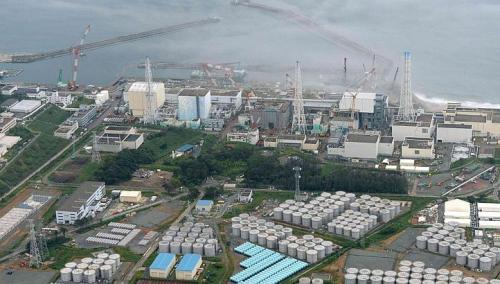
Tokyo Electric Power (TEPCO) will this month begin taking out fuel rods from a pool inside a reactor building at the tsunami-hit plant, in a technically challenging operation that will test the utility's abilities after months of setbacks and glitches.
Experts say the operation is a tricky but essential step in the decades-long decommissioning process after the worst atomic accident in a generation.
More than 1,500 nuclear fuel assemblies, the bulk of them used, but including 200 new ones, need to be pulled out of the pool where they were being stored when the tsunami smashed into Fukushima in March 2011.
Reactor No. 4 was not in operation at the time but hydrogen from Reactor No. 3 escaped into the building and exploded, tearing the roof off and leaving it at the mercy of natural hazards like earthquakes, storms or another tsunami.
TEPCO says it has not yet found any damage to the assemblies at No. 4, which contain an mixture of uranium and plutonium, but will be monitoring for abnormalities.
The removal of fuel is part of regular work at any nuclear power plant, but "conditions are different from normal because of the disaster," said company spokeswoman Mayumi Yoshida.
"It is crucial. It is a first big step towards decommissioning the reactors," she said. "Being fully aware of risks, we are determined to go ahead with operations cautiously and securely."
Chunks of debris that were sent flying into the pool as reactor buildings exploded have largely been removed and a crane has been installed. A protective hood has been erected over the building's skeleton in a bid to prevent radioactive leaks.
A remotely-controlled grabber will sink into the pool and hook onto a fuel assembly, which it will pull up and place inside a fully immersed cask.
The 4.5-metre (15-foot) bundles weighing 300 kilogramme (660 pounds) have to be kept in water throughout the operation to keep them cool, the spokeswoman said.
The 91-tonne cask will then be hauled from the pool -- containing as many as 22 fuel assemblies and a lot of water -- to be loaded onto a trailer and taken to a different storage pool where the operation will be reversed.
Experts warn that any slip-ups could quickly snowball and even minor mishaps will create considerable delays to the already long and complicated decommissioning.
"This is the first practical milestone for the project," said Hiroshi Miyano, a nuclear systems expert and visiting professor at Hosei University in Tokyo.
"Any trouble in this operation will considerably affect the timetable for the entire project," he said. "This is an operation TEPCO cannot afford to bungle."
Miyano's comments reflect an increasingly widespread view that the giant utility is not capable of dealing with the mess its nuclear plant has created.
Months of setbacks have included multiple leaks from tanks storing the water used to keep reactors cool, and a power outage caused when a rat electrocuted itself on a circuit board.
TEPCO's management of the problems has been criticised as haphazard and uncoordinated, with one government minister saying it was like watching someone playing "whack-a-mole".
The full decommissioning of Fukushima is likely to take decades and include tasks that have never been attempted anywhere in the world, such as the removal of reactor cores that have probably melted beyond recognition.
Meanwhile, villages and towns nearby remain largely empty, their residents unable or unwilling to return to live in the shadow of the leaking plant because of the fear of radiation.










1732354127-0/Untitled-design-(3)1732354127-0-270x192.webp)






COMMENTS
Comments are moderated and generally will be posted if they are on-topic and not abusive.
For more information, please see our Comments FAQ